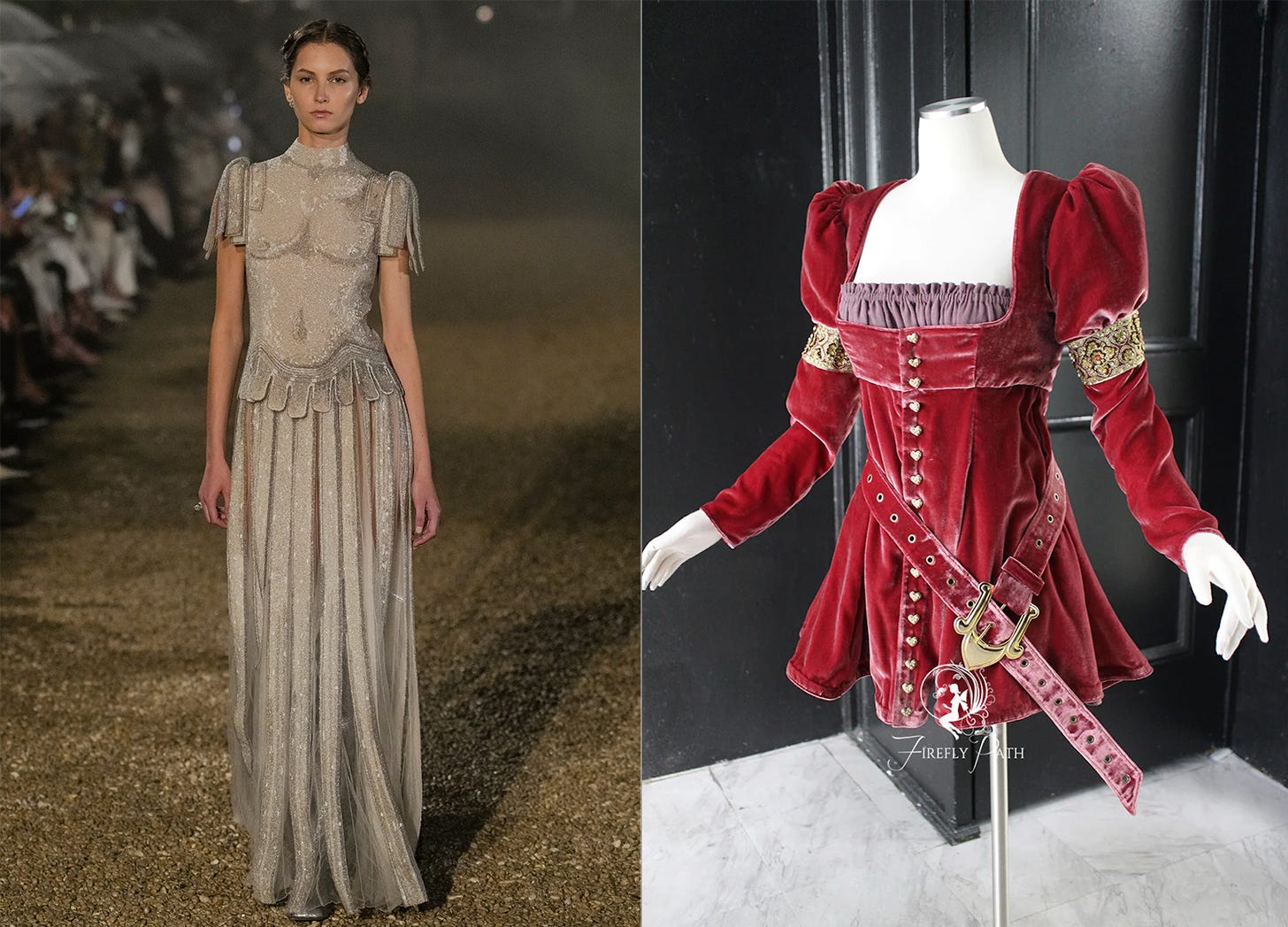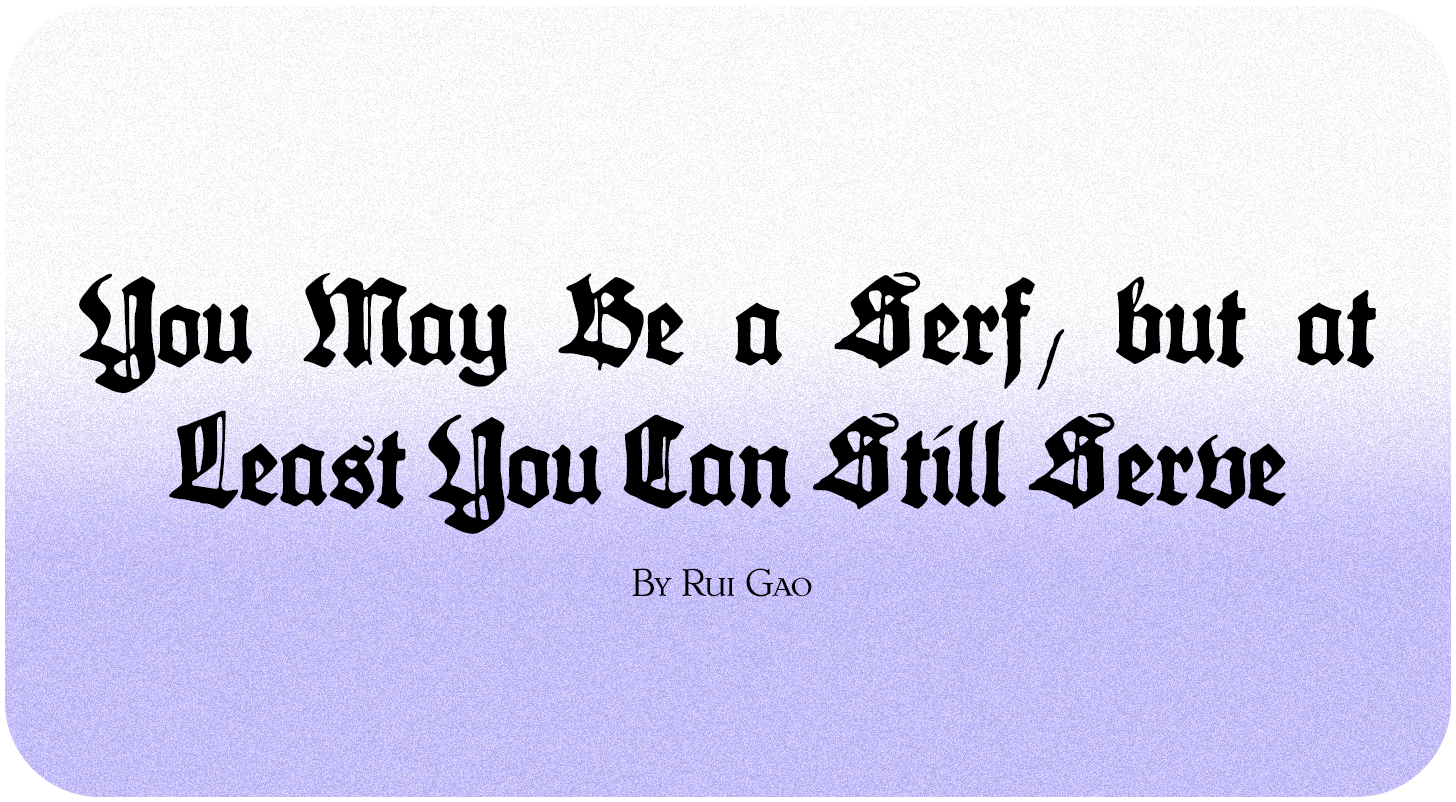You May Be a Serf, but at Least You Can Still Serve
To celebrate the launch of The Medievalist, our first print issue, we’re publishing a selection of stories from the magazine, plus a few newsletter-only additions, for all of you wenches to enjoy. Today, artist Rui Gao explores how the rise in medieval fashion aesthetics could be an act of political defiance. The Medievalist is available for purchase online, now!
POV: The year is 1320 and beads of sweat constellate your brow as you tirelessly sow wheat. You live on a grand estate — but don’t get your hopes up. You are just another penniless peasant on a fief.
This is the unfortunate life of an average person during medieval times.
While it might sound foreign, we are currently living with similar realities in our digital fiefs. In these online kingdoms, we are unpaid laborers producing data for the cloud empires of Amazon, Google, Meta, and Apple. So how do we cope with such a stark reality?
We choose to situate our dreams in the past when the future seems so grim. Online trends are often born out of escapist desires to flee these realities. Politics has long spurred shifts in fashion trends and behaviors. In fact, we’re living through one of those shifts now.
We live in a realm that's evolved past capitalism: a new regime where data is the dominant currency, economist Yanis Varoufakis argues in Technofeudalism: What Killed Capitalism. We’ve become “cloud serfs” producing algorithm-training material for free while Big Tech monetizes our identity, attention, and habits. Tapping to pay, clicking add to cart, scrolling through your feed – each action fleshes out another piece of binary code in your digital identity, driving you further down the funnel across countless privately-owned realms that you will never fully access.
In fashion, this manifests most visibly through the algorithmic webs of fast fashion and microtrends. Platforms like TikTok and Instagram spur the trend cycle forward at increasingly higher speeds; micro-aesthetics are born, peak, and decay in the span of weeks. This phenomenon produces poorly-made garments in response to the demands of the trend cycle, only for these pieces to be quickly discarded once these trends die. Historic fashion honors meticulousness, intentionality, and craftsmanship. Every garment becomes a small, personal act of rebellion towards a system that reduces our existence to data points. This is just the latest chapter in a long history of political resistance expressed through clothing.
Fashion’s connection to political resistance is well-documented. In the 19th century, during the first wave of feminism, Amelia Bloomer’s eponymous garment — loose, ankle-length pants — symbolized comfort, defiance, and liberation from the restrictive corsets of Victorian dress codes. In the 1960s and ’70s, as part of the anti-Vietnam War movement, hippies expressed their anti-establishment, anti-war politics through flowing garments, tie-dye, black armbands, and flower crowns. Clothing became both a protest and a utopian manifesto that honored peace, rejected militarism, and defied norms of gender, class, and consumption.
Take, for instance, the punk subculture, born in the 1970s out of England’s depressed sociopolitical and economic conditions. The “DIY mindset” is a core component of punk styling, and commonly associated elements include bondage trousers, ripped tees, and spikes.
Today’s revival of medieval fashion feels similarly rooted in rebellion, but with a fantastical twist. Medievalcore is how we dream of a slower, more sovereign life, severed from our digital overlords. As Summer Anne Lee, fashion historian and adjunct instructor at the Fashion Institute of Technology, puts it, "trends like medievalcore that romanticize the past can be interpreted as a longing for a time that’s seen as simpler and more beautiful.”

Medievalcore has a long history of being romanticized through the ages, especially in face of alarming technological or societal advances. The Victorian-era Arts and Crafts movement rejected the mechanized ugliness of the Industrial Revolution. The 1970s’ kitschy psychedelica-infused medieval revival flourished with velvet capes, bishop sleeves, and Arthurian silhouettes seen in the jewel-toned collections of The Fools Clothing Collective and bohemian gowns of artist and fashion designer Thea Porter. Even recently, the bardcore trend on TikTok during early-COVID times prompted the creation of tavern-inspired remakes of popular tunes. Medieval fashion consistently maintained its appeal throughout the years because “European tailoring methods were not very complex,” says Lee. “We see gowns, tunics, hose, and headwear made from simple shapes with bold color combinations. Building off of the same concept, medieval fashion is extra fun when we get into more exaggerated proportions.”
Contemporarily-speaking, Ann Demeulemeester’s unicorn-inspired 2020 fall ready-to-wear collection played with the creature’s mythical, noble ancestry and its role as the symbol of Scotland. Lush velvets, rich brocades, and opulent jewel tones construct the dramatic puff-sleeves and crinolines that shape the collection’s modernized tunics and gowns. At Dior’s 2026 Cruise show in Rome, Maria Grazia Chiuri sent out armor-inspired corsets, heraldic embroidery, and baroque capes.
One of my favorite examples is the Medieval Revival Collection by indie brand Firefly Path. The ethereality of elven princesses combined with classic medieval silhouettes, headwear, and jewelry forms the most enchanting capsule fit for a heroine of a bygone era.

Some might say that the resurgence of medieval aesthetics online itself isn’t an entirely authentic way of escaping the cloudalists. After all, the algorithm pushes similar material to us based on the content with which we’ve previously interacted. Mere exposure effect takes over, and a new question arises: Am I interested in this aesthetic just because it’s trending, or do I genuinely like it? Asking this is the first step in reclaiming your identity and autonomy over the capitalist machine. The next part involves seeking out ethical, well-made garments that fit the bill. Ultimately we do have free will in deciding to actually execute certain trends. Your personal style itself can be a form of escapism (and rebellion).
In my experience documenting my fashion journey online, micro-trends and micro-aesthetics both irritate and fascinate me. The revival of medieval designs resonate with many of our shared sentiments of wanting to slow down, to take time to appreciate beauty and craftsmanship. Historic fashion reminds us of the intention in slowly exploring our identities through curating a smaller, more meaningful wardrobe. One chainmail garment can take days — even months — to create. You’re not actually supposed to own an entire armory of these relics. Just enough to help you cope in the face of a digital apocalypse.
Documenting their character growth online for the past five years, Rui Gao loves to explore personal style and agency in the digital age. In their spare time, they enjoy matcha lattes and collecting stickers. They humbly invite you over for afternoon tea in their corner of the Internet at @rui.gaoo.




